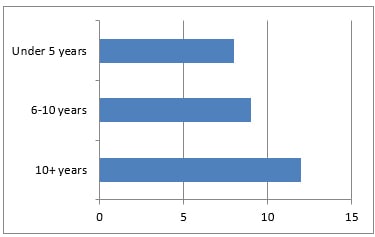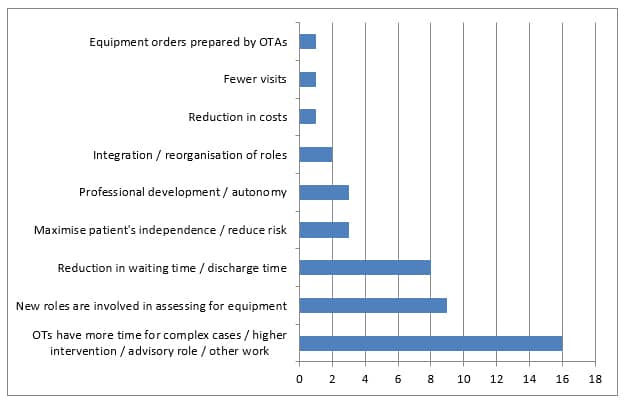Time to prioritise a trusted formula?

Changing demographics and increasing budget pressures are dictating the need for better partnership working between housing, health and social care. Smarter ways of working are essential to ensure better outcomes for service users and to alleviate the daily pressures facing health and social care professionals. Occupational therapists (OTs) are among those most affected by increasing caseloads and limited resources.
For 50 years, the Disabled Living Foundation (DLF) has been supporting OTs in equipment assessment practices. Trusted Assessor training has been a cornerstone of our service, alongside the Hamilton directories of yesteryear and our current knowledge base, DLF Data. The time was right for a reappraisal of the Trusted Assessor concept and in 2018, we interviewed a range of practitioners, collated their feedback and updated DLF’s portfolio of training courses and tools.
At its heart, the genius of Trusted Assessor is its simplicity: by training a variety of staff to provide advice and carry out basic assessments for equipment for independent living, we can reach more vulnerable people, more quickly. We interviewed over 50 professionals in health, housing and social care across the UK to find out their perspective of the Trusted Assessor concept and how it had impacted on the way they worked.
The concept has been around for almost twenty years and has been an integral part of many of our respondents’ organisations, in some cases for many years. Over 40% of respondents told us that Trusted Assessor had been first introduced to their organisation over 10 years ago, a further 31% had been using it for six to 10 years and a further 27% had introduced it within the past five years.

We found around 60% of respondents had 10 or under trained Trusted Assessors in their organisations, with 18% between 11 and 25. Three organisations reported having over 50 trained Trusted Assessors.
We asked respondents about the impact of using Trusted Assessors within their workplace/role. Following the introduction of Trusted Assessors, almost a quarter mentioned the reduction in waiting times. Many mentioned how the new skills they had acquired enabled them to be confident in their understanding of equipment and in assessing for minor equipment and low-level interventions, such as bathing aids, grab rails and toileting equipment.
“At its heart, the genius of Trusted Assessor is its simplicity: by training a variety of staff to provide advice and carry out basic assessments for equipment for independent living, we can reach more vulnerable people, more quickly.” Clare Barber
Being able to respond more quickly and having equipment installed in a timely manner created a much better overall experience for the service user. One respondent (#53) quoted: “Using a trusted assessor is a good way forward for a person being referred to social services requesting an assessment, compared with going to panel which takes a long time for work to be completed.”
Respondents also reported that staff such as OTAs felt more confident and that the addition to their skill set added another dimension to their jobs, improving their satisfaction levels. Other respondents reported faster discharge times from hospital. Housing providers felt that service users were receiving a better quality of service.
The survey findings demonstrated that there are benefits in introducing new ways of working for both staff and service users.
Spontaneous responses to the question about how roles have changed are set out below:

DLF recently worked with Sandwell Metropolitan Borough Council to train technicians to enable them not only to deliver, but to set up, demonstrate and review the effectiveness of equipment once it was in a client’s home. They also wanted to ensure that technicians were able to recognise any potential risks in other areas within the home. Following the training, learners reported they were confident in their new duties. The training was followed by a policy update with regards to equipment and assessment and a review of equipment suppliers. Sandwell has reported a reduction in re-visits and a greater capacity within their therapy services as a result of the programme.
“Trusted Assessor training can be viewed as a transformation tool.” Clare Barber
Trusted Assessors have sometimes been viewed as a way of replacing the work of the occupational therapist. However, our survey suggests the opposite: 40% of interviewees stated that because OTs now had the ability to delegate assessment work to confident staff, they could prioritise home visits and focus on more complex cases, allowing them to spend more time, and achieving better outcomes, with the needier cases.
For example, one respondent (#30) stated: “OTs can assess more complex needs and spend more quality time with clients with hands on therapy.”
Respondent #24 reinforced that: “There is a place for people to do low level assessments instead of OTs.”
This view was also shared by #8: “It is important social workers are trained as assessors because our council has merged with the NHS and OTs are now being spread very thinly.”
An interesting aspect of the survey was exploring what future plans our professionals envisaged in their teams and organisations. Of those that responded, 29% focused on how they could involve others to receive training in an aim to reduce care packages, enhance partnership working and to be able to delegate to support staff. Others mentioned being able to translate what they had learnt to assist with assessing real life scenarios, for example when standard equipment sizes do not work in modern homes.
Trusted Assessor training can be viewed as a transformation tool. DLF recently trained 45 learners from Royal British Legion, the country’s largest armed forces charity. Learners were a mixture of Independent living advisors, regional leads and handy van fitters who were taught how to recognise a need for equipment, how it might enable independent living, measure for it and fit it into the environment. Feedback was that leaners felt more knowledgeable and confident and this in turn has led to more accurate and up-to-date advice and guidance being given to RBL beneficiaries.
They also reported feeling more able to communicate with external services, such as local councils. The charity believes that they are now undertaking a more comprehensive and robust approach towards tackling the increasing demands and casework within their independent living service.
DLF firmly believes that Trusted Assessor training is a key tool that should be in the kit of professionals to help create smarter ways of working.
In 2018, DLF developed a new suite of courses aimed at closer alignment with specific job roles, as well as a choice of competency levels of Trusted Assessor training. Later on this year, DLF will introduce versions of those courses that specialise in certain settings and product categories to support the increasing specialisation of organisations and new technologies.
Also, in 2019 we will launch a conversation about the development of a registration scheme and professional support network.
We are keen to raise the profile of Trusted Assessor training so that it has national recognition as an essential tool for professionals.
“DLF firmly believes that Trusted Assessor training is a key tool that should be in the kit of professionals to help create smarter ways of working.” Clare Barber
One thing we know for sure is that change is inevitable and Trusted Assessor training has shown it is a relevant and effective tool that works and is flexible enough to be here for the long haul.
About Trusted Assessor
Created over 15 years ago, the Trusted Assessor concept has evolved and become the standard new way of working for service provision. Created by a working group put together by government to increase equipment provision, the Trusted Assessor Framework lays out competencies that should be held for a person to prescribe equipment safely. DLF, a part of the original working group, created the original popular training course to meet the competencies and ensure learners could gain knowledge required for equipment provision.
DLF has trained over 10,000 people in various sectors from local authorities, domiciliary agencies to housing associations. The concept has proven to reduce waiting lists for OT departments, increase equipment provision and decrease hospital admissions.
DLF Training can be contacted on 0207 289 6111 or training@dlf.org.uk our website is https://training.dlf.org.uk/

